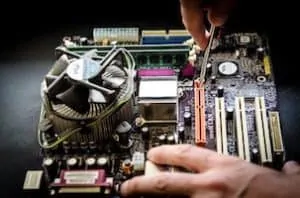The application of advanced forecasting and planning methodologies improve inventory management in a critical, high-volume repair and reverse logistics optimization business, dramatically reducing costs and fulfillment cycles while improving customer satisfaction.
When one of the world’s leading manufacturers of personal computers set new goals for its European operations, ModusLink was there to help.
The OEM turned over management of one of the most critical, high-volume segments of its reverse logistics program—the processor business—saving the manufacturer millions of dollars each year; reducing excess inventory; increasing same-day, on-time ship rates; and improving customer satisfaction.
Before we start, let’s shortly discuss what a case study is. Teachers, writers from an essays writing service, and some students may know it, but there should be an explanation for the whole audience. A case study refers to a real example of some situation – a particular problem, usually.
It should offer not only a description of the problem but also how it can be (or was) solved. Read on to find out the issues we have faced and how we’ve dealt with them.
The Challenges
- Difficulties forecasting demand in a high-volume repair environment caused inventory costs to skyrocket
- Inadequate planning and execution resulted in excess and obsolete inventory and poor utilization of warehouse space
- Variability of hardware and component sourcing affected production efficiency, causing fulfillment delays and lower customer satisfaction

The difficulties of forecasting demand in a service repair environment caused a major PC manufacturer to keep large amounts of spare parts on hand, resulting in skyrocketing inventory costs and poor utilization of warehouse and factory space.
The Solution
- Implemented a world-class forecasting model to improve inventory management and asset utilization while reducing costs
- Utilized advanced sourcing and materials planning to speed fulfillment cycles and improve service levels for increased customer satisfaction
- Configured a highly structured and efficient reverse logistics program to supplement demand inventory and reduce sourcing costs
ModusLink immediately tackled the forecasting and demand challenges
by implementing its proven demand planning methodology. This solution uses sophisticated rules and procedures to create a feasible demand-driven execution plan that reduces inventory risk by minimizing the amount of time, product and cash a company has tied up in inventory.
The plan considers variability of demand while allowing for rapid changes characteristic of the service repair environment. The new model yielded a dramatic improvement in forecast accuracy, which quickly rose from 35 percent to 99 percent accuracy. Additionally, the client’s inventory levels were reduced by 52 percent or $2.3 million in just the first year.
Once a forecasting model was set up, ModusLink needed to round out the solution with more efficient and cost effective sourcing for the hardware elements. ModusLink’s primary source for processors was the returns management program, which required it to conduct rigorous testing to identify units that could be put back into forward logistics inventory— providing the OEM with significant cost savings, given the exorbitant price tag for processors.
When supply levels are low, ModusLink taps the open market to purchase processors, leveraging its local market expertise worldwide to obtain the right product, at the right price, at the right time.
ModusLink also handles shipments of spare modems, heat sinks, quick- restore CDs (which ModusLink presses in-house) and product documentation. ModusLink continuously monitors the supply levels of all these elements at the PC manufacturer’s central European hub and replenishes stock on a daily basis to ensure that consistent inventory levels are always on hand to meet the forecasted demand.
Reverse Logistics Optimization Results
- Immediately improved demand forecast accuracy from 35 percent to 99 percent
- Reduced spare parts inventory levels by 52 percent or $2.3 million in the rst year
- Reduced cycle time by 70 percent from 3.35 to 1.10 days
- Improved on-time, same day ship rates from 84 percent to 99 percent
- Reduced obsolescence by 75 percent
- Improved efficiencies in supply chain related processes by approximately 15 percent
ModusLink was able to reduce product excess and obsolescence by 75 percent, resulting in significant cost savings and improved asset utilization for the manufacturer. In addition, overall efficiency for supply chain related processes was improved by approximately 15 percent.
With a new demand-planning and sourcing infrastructure in place, ModusLink focused on improving customer service levels within the client’s after market repair-service business by driving process efficiency and distribution improvements. Within one year, ModusLink reduced cycle time by 70 percent, accelerating fulfillment from 3.35 to 1.10 days.
Reverse logistics optimization article and permission to publish here provided by ModusLink. Originally published on Supply Chain Game Changer on December 20, 2017.
- SEO Powered Content & PR Distribution. Get Amplified Today.
- PlatoData.Network Vertical Generative Ai. Empower Yourself. Access Here.
- PlatoAiStream. Web3 Intelligence. Knowledge Amplified. Access Here.
- PlatoESG. Carbon, CleanTech, Energy, Environment, Solar, Waste Management. Access Here.
- PlatoHealth. Biotech and Clinical Trials Intelligence. Access Here.
- Source: https://supplychaingamechanger.com/a-case-study-in-reverse-logistics-optimization/
- SEO Powered Content & PR Distribution. Get Amplified Today.
- PlatoData.Network Vertical Generative Ai. Empower Yourself. Access Here.
- PlatoAiStream. Web3 Intelligence. Knowledge Amplified. Access Here.
- PlatoESG. Carbon, CleanTech, Energy, Environment, Solar, Waste Management. Access Here.
- PlatoHealth. Biotech and Clinical Trials Intelligence. Access Here.
- Source: https://zephyrnet.com/a-case-study-in-reverse-logistics-optimization-supply-chain-game-changer/

